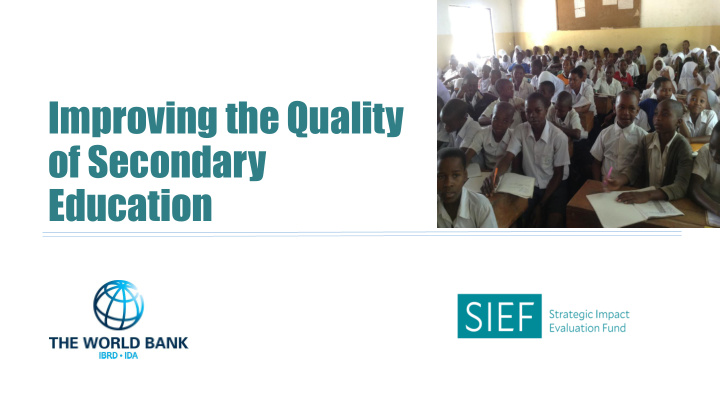



Improving the Quality of Secondary Education
Problem roblem • The main constraint to the quality of secondary education is that classrooms i� �a�y of Ta�za�ia’s 4,064 seco�dary schools are too over -crowded for teachers to teach or students to learn • An acceptable pupil-classroom ratio would be 40:1 • The current average across all of Tanzania is 70:1 and around this average is a lot of variation. In some schools the classrooms are even more crowded. • There are also issues of teacher deployment. Across Tanzania, the pupil teacher ratio is fairly low: 20:1. But there is an excess of social studies teachers and a shortage of math and science teachers, and there is also variation across schools; some schools have too many teachers and some have too few. • But in general, there is a problem of too many students per classroom which means that teachers cannot effectively.
Inter erven ention tion • The government strategy to reduce secondary school overcrowding has three policies • Redeploying teachers (because there is evidence that some schools have much lower pupil-classroom ratios) • Constructing additional classrooms in existing secondary schools • Introducing double-shifting in some schools
Res esearch earch que uestion tion • Does the introduction of double-shifting reduce class size? • Does double-shifting and lower class size increase teacher satisfaction, and increase student outcomes – learning, pass rates and graduation rates? • What are the costs per student and costs per graduate in double-shift schools?
Th Theor eory y of of change ange GOAL OUTPUT OUTCOME(S) INPUT Better jobs, Teachers more income and Change in Reduced class satisfied welfare for school timetable Schools size in schools Students learn Tanzanian Change in operating with More effective more students schedule for morning and teaching/learn Students Better skills teachers and afternoon ing process in repeat and and higher students (6 sessions classrooms dropout less growth for hours/day to 5 economy hours/day)
Evaluation aluation des esign ign • Randomized trial of the introduction of double shifting in schools with excessive class size (total sample estimated as 1000 schools) • Phase-in of program over five years (200 schools/year get double-shift)
Da Data ta col ollect lection ion • List of schools with pupil-classroom ratios over 70:1 • List of teachers in each school (to assign them to morning or afternoon schedule) and their subjects • CSEE (Certificate for Secondary Education Examination) scores • Repetition rates • Dropout rates • Costs (supplemental allowances for some teachers?) • Teacher/school director satisfaction survey (annually)
How How can an res esults ults be us e used ed • If the program produces the intended results, it could affect the decisions about future school construction – because policy makers would see that this approach is less expensive
Asante sana! ASANTE SANA! Secondary Education Group
Recommend
More recommend